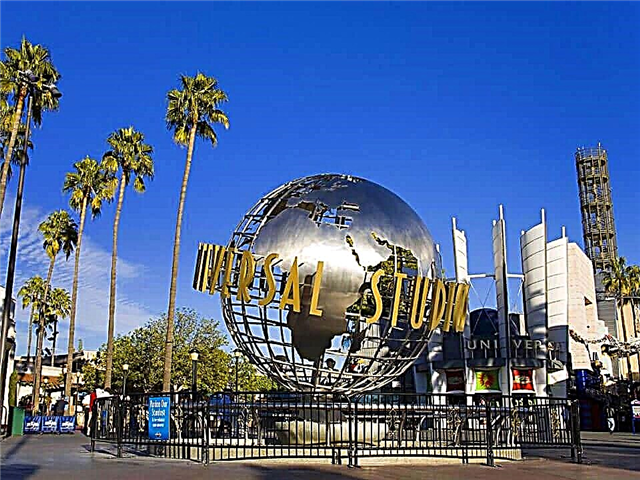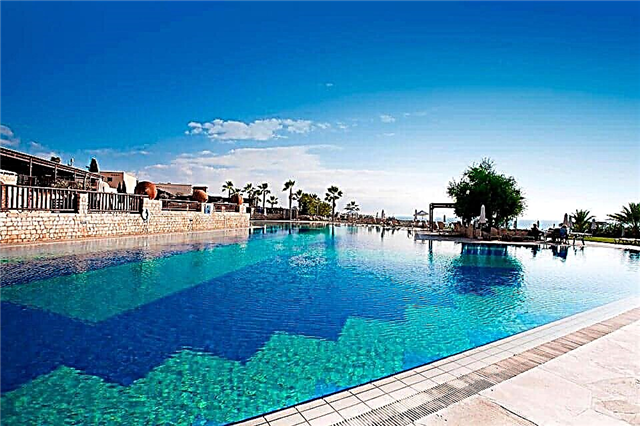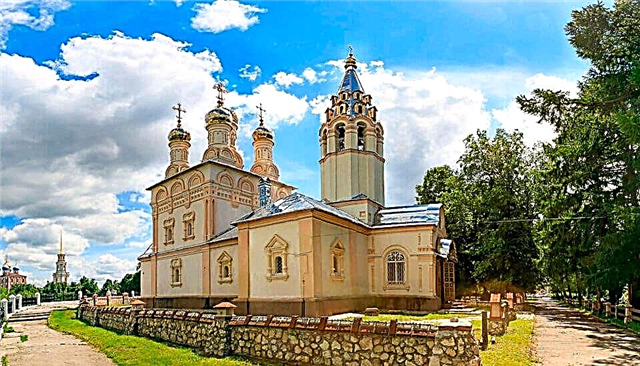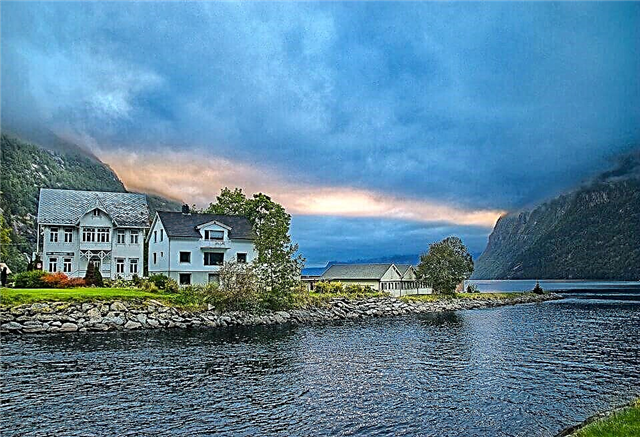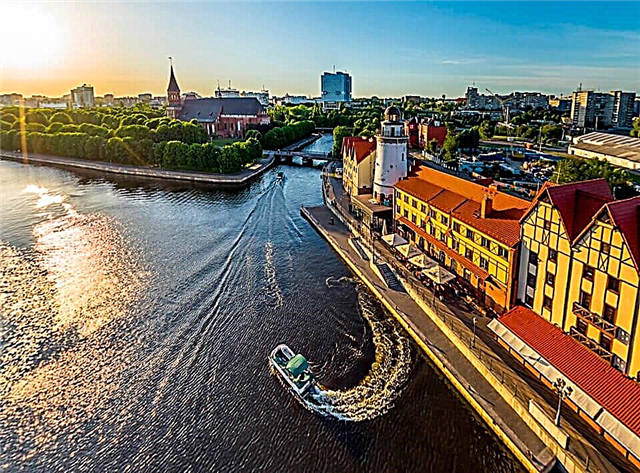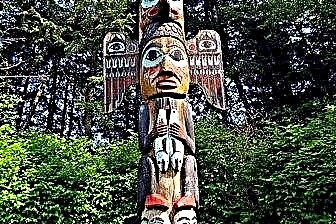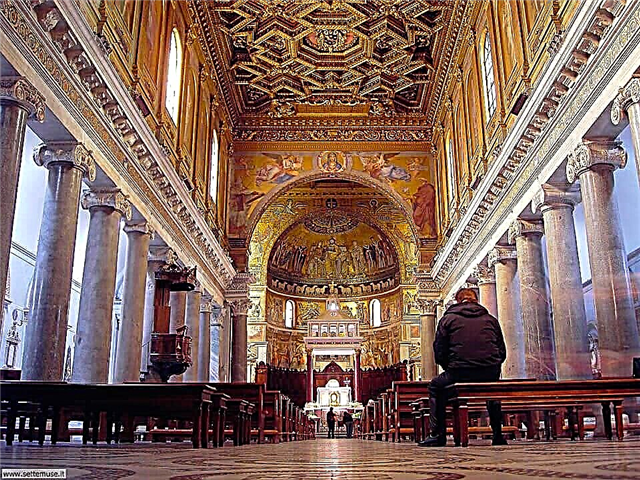Rome is truly monstrously old. Ancient catacombs, ancient temples, grottoes, networks of narrow streets, inconspicuous buildings of the richest churches - all this creates an indescribable atmosphere. And the religious world of Rome is a separate universe with its own laws and traditions. The churches of Rome are so diverse and variegated that one involuntarily begins to doubt which one should be seen in the first place.
Basilica of Saint Peter

The modern St. Peter's Basilica is an iconic landmark in Rome. If all the roads lead somewhere, then it is to this monumental building, which is the real embodiment of history in stone. Thousands of people at different times worked on its design, carried out reconstruction work. This figure is not an exaggeration - the history of this place began in the fourth century, when a small and rather modestly decorated basilica began to be erected over the grave of St. Peter.
By the beginning of the sixteenth century, for some not entirely obvious reason, the Pope initiated the rebuilding of the basilica. Soon, the now already St. Peter's Cathedral appeared - a grandiose structure that symbolizes the power of the pontiff and is the earthly stronghold of the Catholic world. The cathedral is open to the public from 7:00 to 19:00. Free admission. You will have to pay extra for the opportunity to climb Michelangelo's dome - the minimum ticket price is 6 EUR.
Colosseum, Roman Forum, Palatine Hill with one ticket
Time entrance to St. Peter's Basilica with audio guide
Fast track entry to the Vatican Museums and Sistine Chapel
Borghese Gallery: Reserved Entrance Ticket
Skip-the-line: Museums, Sistine Chapel, St. Peter's Basilica
Rome: hop-on hop-off sightseeing bus tour
Rome bus ticket: 24, 48 or 72 hours
St. Peter's Basilica with Dome Climb and Crypt Visit
San Giovanni in Lateranno

The Lateran Basilica is at the highest level of all religious buildings in Rome, surpassing in status such ancient and indisputably revered monuments as St. Peter's Basilica. The archbasilica houses the throne of the pontiff. Once upon a time, the first Christian church in Rome was located on this site. Later, by the ninth century, the Cathedral of St. John the Baptist appeared on the Lateran Hill, which for some time retained the status of the only papal temple.
The real dawn came for the Lateran Basilica, when Borromini undertook its reconstruction, giving the archibasilica bright baroque features. At the same time, huge bronze doors were transported from the Roman Forum itself to be installed at the main portal. The Basilica of San Giovanni impresses with its richness of fresco paintings and mosaics in the classical Byzantine style. Carved ceilings, decorated with stucco columns, sculptures of the apostles, ancient religious artifacts made of silver and precious stones - the basilica justifies the inscription above the main entrance: "the mother of all churches in Rome and the world."
Church of Santa Maria Maggiore

It is impossible not to notice the Basilica of St. Mary, since it is the largest church in the Catholic capital, as its name unobtrusively reminds of: "maggiore" is large. And in front of the very entrance there is a fifteen-meter statue of the Virgin Mary, cast in bronze. It's hard to accidentally walk by. In addition, despite the fact that the date of the founding of the church sends us back to the fourth century AD, this church is almost the only one in Rome that has almost completely preserved its authentic appearance. A legend about the Mother of God is connected with its foundation, who ordered to build a temple in the place where it will snow.
Snow fell, and the church began to be called the Church of the "Mother of God in the Snows", only this event took place in August. The mosaic of the thirteenth century is of striking skill and is dedicated to this subject. The richest ceiling paintings, medieval mosaics and magnificent examples of mosaic art that have survived since the construction of the church tell the story of the life of Christ, convey Old Testament stories. The church consists of three chapels, the most famous of which is the Sistine chapel, so fans of cultural shrines and those wishing to touch the holy relics are guaranteed to be satisfied with a visit here.
San Pietro in Vincoli

The Basilica is also known as St. Peter's Basilica in chains, that is, in chains. It is noteworthy that this artifact, which is an important religious shrine, is kept in a modern basilica. "Honest chains" were here thanks to Eudoxia, the Byzantine queen, who at one time presented them as a gift to the pontiff. She also founded a temple in Rome, which today we call San Pietro in Vincoli.
The basilica is one of the seven largest structures of this type in Rome and for many centuries has been one of the centers of pilgrimage. Its facade looks completely unremarkable, however, this is not surprising. Outward modesty characterizes most buildings of the fourth century. But most tourists come here not for the sake of sacred relics, but to see with their own eyes the stunning tomb of Julius II by Michelangelo with a sculptural composition of forty figures and undoubtedly the ingenious sculpture "Moses" by the same master.
Santa Maria Sopra Minerva

This building, made of light stone, is one of the main temples of the Dominican order. It was donated to the order in the eighth century. Then on the site of the modern basilica there was a rotunda named after Minerva after the name of the ancient temple of the same name, which was located nearby. It was here that at one time Galileo and Count Cagliostro "voluntarily" renounced their views. It is quite difficult not to recognize Santa Maria sopra Minerva.
This is almost the only temple in Rome, made in the Gothic style with pointed arches and sky-blue vaults, skillfully painted with stars. Unfortunately, medieval Gothic did not reach us in its purest form - in the appearance of the basilica, elements of the Baroque traditional for Florentine masters and Rome are still ironed. The main value of the temple is still the statue of Christ with the cross, which is attributed to the works of Michelangelo. It is sustained in the spirit of Antiquity and demonstrates the moment of the resurrection of Christ.
Santa Maria del Popolo

Quite a large building, decorated in gray and blue tones, makes very few people look at it, but behind such an unremarkable shell, real treasures are hidden. According to legend, once on the site of the basilica there was the grave of Nero, over which a poplar gradually grew, quickly chosen by crows. This place was already considered cursed, and the appearance of a bony tree and black birds made the picture even less attractive. Everything changed at the end of the eleventh century when the Pope had a dream. The Virgin Mary commanded to destroy the poplar and create a temple in its place.
First, the chapel appeared, and then the basilica itself. You can talk about the interior of this place for hours - many geniuses of their era left their masterpieces here. So, at different times, Giovanni Bernini worked on the design of the chapels, who gave the building a baroque look, Rafael Santi, who decorated the dome with a large-scale and in terms of scope, and in terms of design, the Creation of the World mosaic, Caravaggio, an Italian master who gave this place two his paintings, and Pinturicchio, although the work of the latter tourists will not be able to see. The chapel, which he designed, was badly damaged and was already reconstructed by Bernini.
Church of San Clemente

There is a small church to the east of the Colosseum, but under the low vaults there is a real treasure trove of Christian relics dating back to the time of Emperor Nero. Oddly enough, but in this basilica you can worship even Orthodox saints, in particular the relics of Cyril, who created the Slavic alphabet. The tomb of St. Clement - one of the most important components of the basilica - is on the lower level. Local mosaics are of interest. In modern terms, they are more like comics, besides, many inscriptions are made in a style that is far from high.
This allows linguists to talk about the existence of the early Italian language. The ruins of an early Christian temple were discovered under relatively new premises from the Middle Ages in the twentieth century. Of particular interest is the temple of Mithra, which dates back to the third century. Nowadays, a grotto has been preserved from it, in which benches and an altar made of stone stand under the vaulted ceiling. But the archaeologists did not stop there either - under the grotto were the remains of civilian buildings destroyed during the time of Nero.
Santa Maria in Cosmedin

The church has a laconic, strict design and is located on the left bank of the Tiber. Until the fourth century on the site of the church was the Forum of the Bull, and even earlier - an ancient temple built in honor of Hercules. The first building served civil needs - it acted as a distribution point for food to the poor, but gradually all charitable foundations were concentrated in the hands of the Holy See, and by the seventh century the complex itself became the property of the Greek community, which fled to Rome when Byzantium fell.
Even in the sovereign name of the church, there is an echo of those times: "kosmidion" - from the Greek "beautiful". Such a characteristic was not accidental - the interior decoration of the temple is truly amazing. Cosmati's floors, an authentic Gothic red granite altarpiece, an Easter candelabrum from the thirteenth century, fragments of the Epiphany mosaic (the rest are kept in St. Peter's Basilica and in the Uffizi Gallery in sunny Florence) can all be seen in the chapels.

The bell tower - one of the tallest in Rome - is extremely delicate and decorated with multi-colored majolica. A somewhat unusual symbol of the church is the "Mouth of Truth" - a marble slab reaching almost two meters in diameter. The exact application of this echo of Antiquity is still not entirely clear, but the Triton mask that adorns it is definitely of interest to tourists.
Santa Maria in Trastevere

Oddly enough, but this basilica - due to a number of historical circumstances - has become one of the most popular basilicas among the Orthodox population. Two Orthodox icons were even installed at her altar, but it should be understood that the history of the creation of the church itself is in no way connected with Orthodoxy. It is important to understand that Santa Maria in Trastevere is considered almost the first Christian basilica officially allowed in Rome. The modern building was mostly erected in the twelfth century.
The main building materials were travertine blocks, which were taken from the ancient thermae. At the time, this practice was common. The facade is decorated with the image of the Virgin Mary with Jesus in her arms. The fresco dates back to the thirteenth century. The interior space - with high ceilings, stucco and gilding - is "bordered" with mosaics in the cosmatesco style.
Church of Santa Sabina

The basilica is located on the Aventine hill and is part of the monastery complex of the Dominican order. It was erected on the remains of the matron Sabina, revered in Rome. By the tenth century, local authorities appreciated all the advantages of the location of the basilica and turned it into a fortification. However, this state of affairs did not last long - soon the building of the church began to pass from the hands of one noble Roman family to the hands of another.
The series of rebuildings was interrupted only by the middle of the twentieth century, when the Dominican order wished to return the basilica to its authentic appearance. So, she was able to preserve all the characteristic features of the ancient Roman structure. If you find yourself in the Church of Santa Sabina, be sure to go to the courtyard where the ancient orange tree grows. According to legend, this tree was the first orange tree grown in Italy.
Sao Paolo Fuori le Mura

This basilica is one of the four so-called patriarchal basilicas in Rome. It is located outside the city walls in the place where, according to legend, the Apostle Paul was buried. However, recently the apostle's sarcophagus was indeed found. The first version of the basilica seemed to Theodosius I insufficiently majestic for a place so significant for the entire religious world.
Large-scale construction began, which marked the beginning of the construction of the modern church. The building that can be seen today has a classic look. The facade is decorated quite strictly and is decorated with the figure of Christ, on both hands of which are the apostles: Peter and Paul. The design contains echoes of the Byzantine style, as well as Gothic and Baroque architecture. The basilica is especially proud of the ancient organ, the last reconstruction of which took place in the twentieth century.
Sant Andrea al Quirinale

This church is another outstanding project by Bernini, commissioned by the Jesuit Order on Quirinal Hill. The order needed a place for a novitiate, that is, a period of novice, the institution of which was introduced in the sixteenth century. Once on the site of Sant'Andrea al-Quirinale there was an old church, whose building is too dilapidated. Only one foundation remained - a powerful foundation, on which a new baroque basilica was erected for ten years.
Bernini himself considered it one of his best creations and could sit inside for hours, enjoying the knowledge that this work of architectural thought belongs to his authorship. The interior space of the church is very contrasting - the dark side panels favorably set off the well-lit central part of the room. The dominant feature of the interior is the painting The Martyrdom of Saint Andrew by Guillaume Courtois.
Church of Saint Praxeda

This architectural monument of the ninth century does not stand out too much against the general background of Roman streets. The almost bare facade contrasts strongly with the splendor and luxury of interior decoration. It is here that the titular church is located, which is known for the most part for the beauty of ancient frescoes and the presence of a large number of remains of saints and great martyrs. It is named after Saint Praxeda and is located on the site of the former baptistery, dedicated to the same saint.
The life of this woman has come down to us in retellings and legends, but she became famous mainly due to the fact that she buried martyrs walled up in the Roman catacombs according to the canons of the Christian rite. Today, the crypt contains over two thousand remains of saints. Their names are engraved on marble slabs.
San Lorenzo fuori Mura

This church, unusual from an architectural and historical point of view, is located outside the city walls, since earlier Christian churches were erected on the burial places of martyrs who, as the canons require, gave their lives for the faith. And they were buried according to the old Roman customs outside the city walls. The design of the church is more than original: in fact, it is a series of independent churches that were simply connected.
Until World War II, the church of Pope Pegalia and the church of Pope Honorius were clearly visible in its appearance, but one enemy shell destroyed this amazing symbiosis. Most of the valuable frescoes were lost, only marble frescoes and a few early Christian sarcophagi have survived. Also, the old part of the church, dating from the sixth century, has not actually been damaged.Other premises had to be reconstructed.
Church of Santa Constanta

The first versions of the temple date back to the third century AD. Its construction is associated with the name of Constantine the Great, who decided to build a mausoleum for his daughters. The construction was started immediately, and very soon a neat light building with ornaments, mosaics with images of Jesus Christ and a finely painted dome appeared on the Nomentarska road. True, the mausoleum gradually began to turn into a basilica: first, a baptismal font appeared for the baptismal ceremony, and then other attributes of the church. This is how we see her today.
In Rome, GuruTurizma recommends the following hotels:

